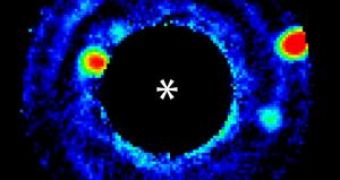Until now, scientists have used various techniques to detect more than 200 exoplanets. Most of these exoplanets are from five to 4,000 times more massive than Earth, and are either too hot, too cold or too much of a giant gas ball to be considered likely habitats for life. So far, no one has managed to capture an image of an exoplanetary system that resembles our own solar system.
While detecting exoplanets is relatively easy, actually photographing them is very difficult, thanks to their feeble light being swamped by other light sources over the massive distances involved. The task has been compared to looking for a firefly next to a searchlight.
NASA researchers have customized a space telescope with special masks and mirrors which they believe could allow it to take photographs of planets orbiting other stars (exoplanets). Although the apparatus has only been demonstrated in the laboratory, the successful test marks a dramatic step forward for missions like the proposed Terrestrial Planet Finder, designed to hunt for an Earth twin that might harbor life.
"Our experiment demonstrates the suppression of glare extremely close to a star, clearing a field dark enough to allow us to see an Earth twin. This is at least a thousand times better than anything demonstrated previously," said John Trauger, lead author of a paper describing the system, called the High Contrast Imaging Testbed, and how the technique could be used with a telescope in space to see exoplanets. The lab experiment used a laser as a simulated star, with fainter copies of the star serving as "planets."
Coupled to an adjustable mirror, it could enable a space telescope to image a distant planet 10 billion times fainter than its central star.
This result is important because it points to the way of building a space telescope with the ability to detect and characterize Earth-like planets around nearby stars.

 14 DAY TRIAL //
14 DAY TRIAL //